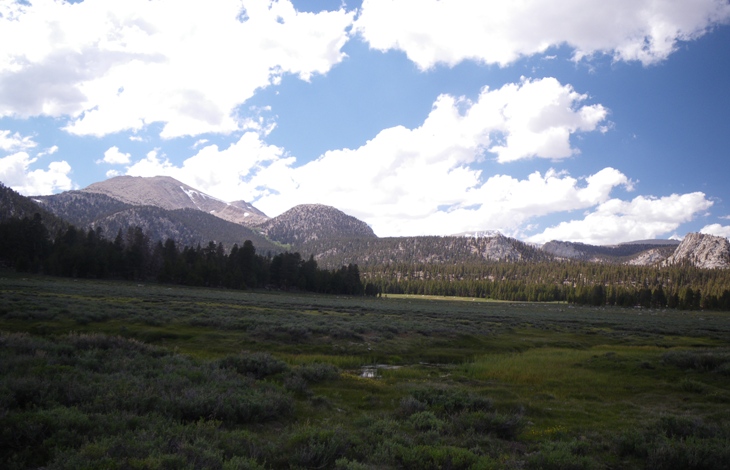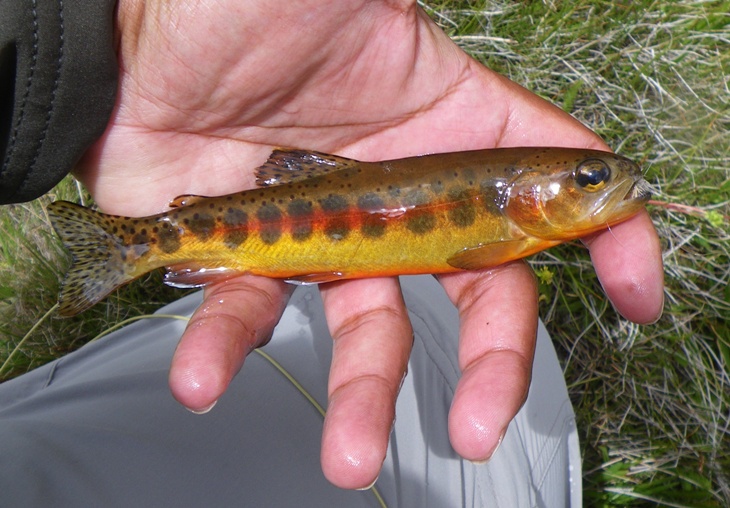|
|
|
|
|
July 3, 2009 Cottonwood Lakes Area
Time:
1pm - 4pm
Narrative: July 1st could be called the unofficial start of the Golden Trout season. Most lakes are open year around in California, even lakes in the high country- if you can get to them. There are exceptions and July 1st signals the first day of fishing season for the lakes in the Cottonwood Lakes basin as well as high country streams in the Lake Tahoe region. Cottonwood Lakes in is Mecca for golden trout fishers. There are the 5 or 6 “Cottonwood” lakes of course and then there are the other lakes and streams which may or may not also contain Golden Trout. Choose wisely and you will be rewarded. It was these other lakes and streams that I had planed to visit. Out of the 13 lakes in the area, I have fished only 4 thoroughly and I was hoping to rectify that and fish an additional 4 on this trip. I was still a bit tired from my trip to India and so I left the house at 4:30am the morning of, instead of the night before as would have been my normal procedure. My wilderness permit was good for pick up until 10am that morning and I walked through the door of the ranger station at precisely 9:57am. Permit in hand I decided to grab some lunch before heading to the trailhead, something I rarely do. I arrived at the trailhead at about 1pm. When one fishes at altitude, in this case 10,000 feet, it is best to acclimate to the altitude before hiking or backing to the location. The accepted way to do this is to spend the night before at the trailhead or somewhere at a similar altitude. Your body starts producing additional red blood cells to carry more oxygen to your muscles and compensate for the low oxygen environment. I generally need to acclimatize at altitudes greater than 8000ft and even though I likely had some acclimatization due to spending the previous weekend fishing at altitude, I decided to take it easy and fish close the trailhead. I’d hike to the first lake I the morning. The weather was partially responsible for that decision, the skies were dark and ominous and I didn’t want to hike in during an afternoon thunderstorm. I spent the afternoon fishing the nearby meadow stream. The stream is tiny and the fish are tiny and it’s not a place that would suit many. Sure there are larger fish there but the fish in general are spooky, spooky, spooky and the larger fish 10 times as much. 4 inch fish abound and if you walk the bank like most do, that’s all you’ll catch 3 and 4 inch fish. The catching of larger fish is tougher than one might think. It’s a catch 22 really, requiring more than stealth. There are so many small eager fish that you really have to target the larger fish. This of course means you have to see them. But the fish are so spooky it makes spotting fish extremely difficult. 8 times of 10 a fish will see you and spook the whole run before you get a chance to find the larger fish. In this situation, distance is a virtue. The further you are away, the harder it is for the fish to see or hear you (sound carries along the bank better than in air or water.) I’m convinced the fish must hold with their bodies partially tilted on the horizontal. They would spot me, sneaking up behind them from 20 feet away. Once I figured out the hierarchy it was a simple matter checking where the big fish was supposed to be and seeing if he was big enough to cast to- in this case, 6 to 8 inches.
I fished until late afternoon and then decided, instead of breaking out my backpacking food, to head into Lone Pine for dinner. I don’t know if it was lunch or dinner or my trip to India or something else but I awoke the next morning in intestinal distress. So much so that after resting at the trailhead for over an hour that morning I decided to scrub the hike into the lakes and return home.
Previous Golden Trout Wilderness Chronicle Next Golden Trout Wilderness Chronicle
|



 The
further up the meadow I fished the smaller the stream became, it forked into
several smaller inlets and surprisingly, I found one of these inlets to have
larger fish. Where the brush was high enough and the stream narrow, I could
get fairly close and pull fish from deep runs and undercut banks, in the
shallow areas my casts would float out across the meadow and land so that my
fly line rested on the meadow grass or marshy bank with just enough leader
on the water to reach the fish.
The
further up the meadow I fished the smaller the stream became, it forked into
several smaller inlets and surprisingly, I found one of these inlets to have
larger fish. Where the brush was high enough and the stream narrow, I could
get fairly close and pull fish from deep runs and undercut banks, in the
shallow areas my casts would float out across the meadow and land so that my
fly line rested on the meadow grass or marshy bank with just enough leader
on the water to reach the fish.